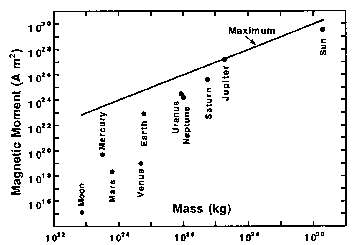Earth & Mercury's Decaying Magnetic Fields
This is the show from Friday May 30th, 2014
Summary:
* Boy do the atheists have a problem: Real Science Radio co-host Bob Enyart interviews physicist Russ Humphreys on the Earth and Mercury's rapidly decaying magnetic fields, and on Dr. Humphrey's fulfilled predictions about the magnetism of the distant planets Uranus and Neptune. With Earth losing 10% of it's magnetic field in just the last 150 years, and Mercury's even faster drop, materialists have to appeal, once again, to claims of wildly coincidental occurrences to explain our observation of such rapid loss on planets that are allegedly billions of years old.
* From the Popular RSR Site YoungEarth.com:
* Earth's Magnetic Field Decay: As summarized by University of Maryland geophysicist Daniel Lathrop, “In particular, over the last 150 years or so, the Earth’s magnetic field has declined in strength about ten percent, and continues to decline in strength [as is evident] every time people go and make new measurements.” Creationists point out that this rapid decay is not expected in such a brief snapshot in time if our planet were 4.6 billion years old. On the other hand, these careful, long-term, and worldwide measurements that document the rapidly decreasing strength of Earth's magnetic field are consistent with a young Earth. Lathrop, not surprisingly, is an old-earthgeophysicist who nonetheless acknowledged this data at the opening of and midway through the 2013 program Magnetic Shield, an episode of The Weather Channel's Secrets of the Earth with theoretical physicist (emphasis on the theoretical), Michio Kaku.
Creationist physicist Russell Humphreys of Sandia National Labs has updated his previous work by publishing Earth's Magnetic Field Is Decaying Steadily, which includes global data through 2010. Humphreys observes that, "in 1968 the International Association of Geomagnetism and Aeronomy (IAGA) began more systematically measuring, gathering, and analyzing geomagnetic data from all over the world. This group of geomagnetic professionals introduced a 'standard spherical harmonic representation' of the field called the International Geomagnetic Reference Field, or IGRF. Every five years starting in 1970, they have published both dipole and non-dipole components of the field. Using older data, the IAGA also extended the model back to the beginning of the twentieth century. With the issuance of the latest data set, IGRF-11, we have a standardized set of geomagnetic data from 1900 to 2010. You can download it free of charge as an ASCII file..." (Incidentally, Humphreys also published accurate predictions of the magnetic fields of Neptune and Uranus before NASA's Voyager mission confirmed his work.)
The steady and rapid decay of the energy of the Earth's magnetic field as documented by the most careful measurements over the forty-year period from 1970 to 2010 is also consistent with previous published results using data going back to 1835, and by inference from other observations, apparently, going back to the 1100s A.D. Further, as with forensic accounting and statistical analysis, numbers can often tell a lot about data, and in this case, analysis of the field strength measurements helps to confirm the validity of the data. Humphreys writes further that the decay patterns, "weigh heavily against the idea that there is currently a 'dynamo' process at work in the core that would ultimately restore the lost energy back to the field. Without such a restoration mechanism, the field can only have a limited lifetime, in the thousands of years." For example, if the energy of the field has been dissipating at the current rate, going back only a million years would produce such heat that the oceans would have burned off the Earth, which clearly they have not.
See also the Real Science Radio Mercury Report at rsr.org/mercury#magnetic-field for that example of a second planet experiencing a rapidly decaying magnetic field and hear Bob Enyart and Fred Williams talk about the Earth's decay rate at RSR's Spiders & Termites & Magnets.
Here's the point: A four-billion year old Earth would have reached stasis long ago whereby changes in something as globally significant as its magnetic field would occur only very slowly. And since the Earth could not sustain the necessary increased energy backward in time for even a million years, let alone billions, to explain its current strength and decay rate, this is significant, worldwide evidence that appears to undermine the alleged great age of the Earth.
* Exercise for the Student: The laboratory experiment represented in the following photo has / has not provided evidence in support of the old-earth "dynamo theory"?

This is the show from Friday May 30th, 2014
Summary:
* Boy do the atheists have a problem: Real Science Radio co-host Bob Enyart interviews physicist Russ Humphreys on the Earth and Mercury's rapidly decaying magnetic fields, and on Dr. Humphrey's fulfilled predictions about the magnetism of the distant planets Uranus and Neptune. With Earth losing 10% of it's magnetic field in just the last 150 years, and Mercury's even faster drop, materialists have to appeal, once again, to claims of wildly coincidental occurrences to explain our observation of such rapid loss on planets that are allegedly billions of years old.
* From the Popular RSR Site YoungEarth.com:
* Earth's Magnetic Field Decay: As summarized by University of Maryland geophysicist Daniel Lathrop, “In particular, over the last 150 years or so, the Earth’s magnetic field has declined in strength about ten percent, and continues to decline in strength [as is evident] every time people go and make new measurements.” Creationists point out that this rapid decay is not expected in such a brief snapshot in time if our planet were 4.6 billion years old. On the other hand, these careful, long-term, and worldwide measurements that document the rapidly decreasing strength of Earth's magnetic field are consistent with a young Earth. Lathrop, not surprisingly, is an old-earthgeophysicist who nonetheless acknowledged this data at the opening of and midway through the 2013 program Magnetic Shield, an episode of The Weather Channel's Secrets of the Earth with theoretical physicist (emphasis on the theoretical), Michio Kaku.
Creationist physicist Russell Humphreys of Sandia National Labs has updated his previous work by publishing Earth's Magnetic Field Is Decaying Steadily, which includes global data through 2010. Humphreys observes that, "in 1968 the International Association of Geomagnetism and Aeronomy (IAGA) began more systematically measuring, gathering, and analyzing geomagnetic data from all over the world. This group of geomagnetic professionals introduced a 'standard spherical harmonic representation' of the field called the International Geomagnetic Reference Field, or IGRF. Every five years starting in 1970, they have published both dipole and non-dipole components of the field. Using older data, the IAGA also extended the model back to the beginning of the twentieth century. With the issuance of the latest data set, IGRF-11, we have a standardized set of geomagnetic data from 1900 to 2010. You can download it free of charge as an ASCII file..." (Incidentally, Humphreys also published accurate predictions of the magnetic fields of Neptune and Uranus before NASA's Voyager mission confirmed his work.)
The steady and rapid decay of the energy of the Earth's magnetic field as documented by the most careful measurements over the forty-year period from 1970 to 2010 is also consistent with previous published results using data going back to 1835, and by inference from other observations, apparently, going back to the 1100s A.D. Further, as with forensic accounting and statistical analysis, numbers can often tell a lot about data, and in this case, analysis of the field strength measurements helps to confirm the validity of the data. Humphreys writes further that the decay patterns, "weigh heavily against the idea that there is currently a 'dynamo' process at work in the core that would ultimately restore the lost energy back to the field. Without such a restoration mechanism, the field can only have a limited lifetime, in the thousands of years." For example, if the energy of the field has been dissipating at the current rate, going back only a million years would produce such heat that the oceans would have burned off the Earth, which clearly they have not.
See also the Real Science Radio Mercury Report at rsr.org/mercury#magnetic-field for that example of a second planet experiencing a rapidly decaying magnetic field and hear Bob Enyart and Fred Williams talk about the Earth's decay rate at RSR's Spiders & Termites & Magnets.
Here's the point: A four-billion year old Earth would have reached stasis long ago whereby changes in something as globally significant as its magnetic field would occur only very slowly. And since the Earth could not sustain the necessary increased energy backward in time for even a million years, let alone billions, to explain its current strength and decay rate, this is significant, worldwide evidence that appears to undermine the alleged great age of the Earth.
* Exercise for the Student: The laboratory experiment represented in the following photo has / has not provided evidence in support of the old-earth "dynamo theory"?

Last edited by a moderator:

